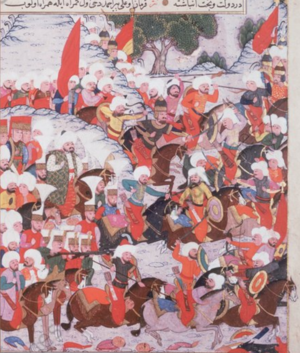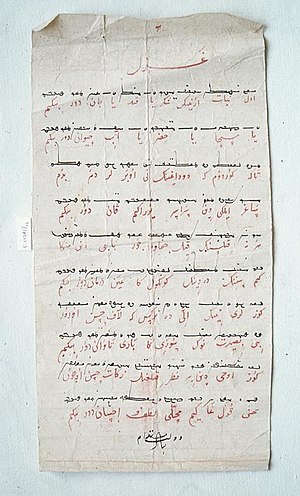Battle of Otlukbeli
| Battle of Otlukbeli | |||||||
|---|---|---|---|---|---|---|---|
| Part of the Ottoman-Aq Qoyunlu wars | |||||||
 17th century Turkish miniature depicting the battle | |||||||
| |||||||
| Belligerents | |||||||
| Ottoman Empire | Aq Qoyunlu | ||||||
| Commanders and leaders | |||||||
|
Mehmed the Conqueror Şehzade Mustafa Şehzade Bayezid[2] Davud Pasha[3] |
Uzun Hasan Ughurlu Muhammad Zayn-al-Abidin Mirza † | ||||||
| Strength | |||||||
| 70,000–100,000[4] | 70,000 mostly cavalry[4] | ||||||
| Casualties and losses | |||||||
| 1,000[5]–4,000[4] |
20,000–34,000[5] 4,000 executed, 2,050 captured[6] | ||||||
The Battle of Otlukbeli or Otluk Beli was a battle between Aq Qoyunlu and the Ottoman Empire that was fought on August 11, 1473.
Background
In autumn of 1463, Republic of Venice opened negotiations with Uzun Hasan. In 1464, Uzun Hasan intervened in central Anatolian affairs. Although Mehmed occupied Karaman in 1468, he was unable to subjugate a number of Turkoman tribes living in the mountains which extended to the Mediterranean coast. These tribes were not subdued for the next fifty years, and from time to time rose in revolt around pretenders to the throne of Karamanids. After the Ottoman occupation of Karaman, Uzun Hasan adopted a more aggressive policy. By 1471, the problem of Karaman had become a serious threat to the Ottoman power. Uzun Hasan formed alliance with the Venetians and established contacts with the Knights of Rhodes, Kingdom of Cyprus and the Bey of Alaiye. He also intended to establish a direct contact with Venice by marching on the Mediterranean coast through the Taurus mountains, then controlled by the Turkoman tribes. Although a few Venetian ships landed on the coast, they could not find Uzun Hasan's men. In 1472, a crusader fleet attacked the Ottoman coasts. Uzun Hasan with Karamanid forces drove the Ottomans from Karaman and marched on Bursa. However, Mehmed repulsed the invasion, and formed an army of 70,000 men. In addition to his regular army, he had mercenaries from his Muslim and Christian subjects.[7]
Battle
Mehmed II returned with his army in 1473 to defeat Uzun Hasan. The Turkomans had a traditional army that contained considerable amounts of light cavalry. On the other hand, the Ottoman army exploited the latest technology available at the time. They arrived with handguns and cannons. This difference between the natures of the two armies marked the result of the battle. The Ottoman side gained a decisive victory, whereas the Turkoman army was nearly destroyed in a single day.
Aftermath
Following the defeat of Uzun Hasan, Mehmed took over Şebinkarahisar and consolidated his rule over the area. From Şebinkarahisar he sent a series of letters announcing his victory, including an unusual missive in the Uyghur language addressed to the Turkomans of Anatolia.[8]
The decree (yarlık) had 201 lines and was written by Şeyhzade Abdurrezak Bahşı on 30 August 1473:[9]
Completed when Karahisar was reached on the date of eight hundred and seventy eight, 5th day of the month Rebiülahir, the year of the Snake.
Ibn Kemal made the following statement on the capture of Şebinkarahisar:[10]
On Wednesday 24 August we, the Ottomans, marched to Şebinkarahisar. When we set up cannon and began to destroy the fortifications ... (the governor) Dara Bey came out, seeking peaceful surrender ... We did not remove the existing townspeople ..., but we left there one-thousand of our men with abundant supplies.
Abu Bakr Tihrani in the Kitab-i Diyarbakriyya:[11]
When the Karahisar area became the accommodation place of countless armies, Darab Beg-i Purnak, the owner of that castle, took shelter in the castle. Rum (Ottoman) soldiers surrounded the castle. Darab Beg surrendered the castle out of fear of the Rums.
Ottomans nearly destroyed the power of the Aq Qoyunlu in the East. Aq Qoyunlu would be destroyed completely by Ismail I in later. This victory of the Safavid Empire would create a new enemy for the Ottoman Empire in the East. The race between the two empires ended with the fall of the Safavid dynasty from power in the 18th century.
See also
Primary sources
- Târîh-i Ebü’l-Feth, Tursun Beg
- Tevārīḫ-i Āl-i ʿOsmān, Aşıkpaşazade
- Tevārīḫ-i Āl-i ʿOsmān, Ibn Kemal
- Cihannümâ, Neşri
References
- ^ Somel, Selçuk Akşin, Historical dictionary of the Ottoman Empire, (Scarecrow Press Inc., 2003), xc.
- ^ Babinger, Franz (1992). Mehmed the Conqueror and His Time. Princeton University Press. p. 315. ISBN 978-0-691-01078-6. Retrieved 10 April 2011.
- ^ Har-El, Shai (1995). Struggle for domination in the Middle East: the Ottoman-Mamluk War, 1485–91. Brill. p. 149. ISBN 978-90-04-10180-7. Retrieved 6 October 2010.
- ^ a b c Erhan Afyoncu (1988–2016). "OTLUKBELİ SAVAŞI". TDV Encyclopedia of Islam (44+2 vols.) (in Turkish). Istanbul: Turkiye Diyanet Foundation, Centre for Islamic Studies.
- ^ a b Franz Babinger, Fatih Sultan Mehmet ve Zamanı, çev. Dost Körpe, Oğlak Yayınları, İstanbul 2003
- ^ Halil, İnalcık. "Mehmed II". islamansiklopedisi.org.tr. (in Turkish)
- ^ Halil İnalcık (1973). The Ottoman Empire: The Classical Age 1300–1600. p. 28.
- ^ Babinger, Franz (1978). Mehmed the Conqueror and his Time. Bollingen Series XCVI. ed. by William C. Hickman, trans. by Ralph Manheim. Princeton University Press. p. 316. ISBN 0-691-09900-6.
- ^ Ayşe Gül Sertkaya (2002). "Şeyhzade Abdurrezak Bahşı". In György Hazai (ed.). Archivum Ottomanicum. Vol. 20. p. 112.
- ^ Colin Imber (1990). The Ottoman Empire 1300–1481. p. 217.
- ^ Ebu Bekr-i Tihrani (2014). Kitab-ı Diyarbekriyye (in Turkish). Translated by Mürsel Öztürk. Turkish Language Association. p. 380.
- CS1 Turkish-language sources (tr)
- Articles with short description
- Short description with empty Wikidata description
- Coordinates not on Wikidata
- Articles needing additional references from May 2021
- All articles needing additional references
- Articles containing Turkish-language text
- AC with 0 elements
- Battles involving the Ottoman Empire
- Conflicts in 1473
- Battles of Mehmed the Conqueror
- History of Erzincan Province
- 1473 in the Ottoman Empire
- Battles of the Aq Qoyunlu
